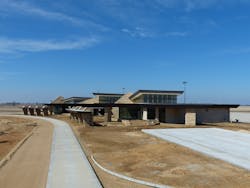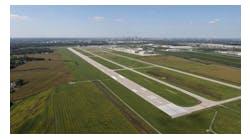Walking through the terminal at Dubuque Regional Airport (DBQ), you can see the evolution of flight in northeastern Iowa.
The linear facility offers a small waiting area with a security screening checkpoint jammed into a hallway between the gate and the luggage belt located next to the main entrance. Adjacent to the mixed arrival/departure area, three rental car counters crowd into the area while airline ticketing counters sit across the hallway. Walking away from the passenger area, a darkened video game room with old arcade machines and empty business room stand idle from a bygone era.
And when you get to the restaurant located on the opposite side of the terminal of where passengers wait for flights, people eat as an Embraer 145 regional jet taxis onto the apron from taxiway Alpha right outside the windows. The plane looks as if it’s about to collide with the glass before making a sharp turn to the gate, squeezing into its resting place.
“You can see how close taxiway alpha is right there,” Dubuque Airport Manager Robert Grierson points out. “The whole building is really three different components. None of which took into consideration larger aircraft.
“Truthfully, it’s designed for a DC3. Now when you’re talking about a 70-seat regional in there, jet it's tough.”
Dubuque’s airport terminal has slogged through 70 years of change, but now its time is finally coming to an end as DBQ opens its new terminal June 16, and ushers in a new future for passengers.
Time well spent
Grierson says DBQ is a Part 139 airport, with about 97 percent of all operations being general aviation. American Airlines flights operated by Envoy Air provide the only commercial service to the airport, with three flights daily going between Dubuque and Chicago O’Hare International Airport (ORD). Sun Country flies charter 737 jets to the airport as well.
It also hosts a Part 141 flight school, run by the University of Dubuque as part of its aviation program.
DBQ is also the only airport in Iowa with a contracted tower, which is VFR-only. It’s currently the second busiest airport in Iowa.
The airport is staffed with 17.8 FTEs and has an annual budget of $4.8 million.
“You can add Waterloo and Sioux City together and we still beat them,” Grierson says. “And they’re 24-hour.”
Todd Dalsing, airport operations and maintenance supervisor for DBQ, has seen the airport evolve since he came through the university’s flight program in 1993 and started working as a part-time line service worker pumping fuel. “At that time it was all Navajos,” he says.” This whole airfield was Navajos and you could jump in from one to the other.”
DBQ’s old facility was first constructed in 1947, which was then expanded in 1969 when another piece was built to move operations over. In 1986 the facilities were merged together.
The linear design of traffic flow creates a major chokepoint in the facility, with the single lane Transportation Security Administration (TSA) security checkpoint, baggage claim, rental car area and greeter areas all converging in one common area.
“It’s just a sea of humanity on occasion,” Grierson says. “It was just never designed to accommodate this kind of traffic.”
Furthering issues is post-security holding area, which holds about 50 people and includes two toilets and vending machines. The lone restaurant is outside of the checkpoint, so Grierson says the only options are either “wolfing down” food quickly before security or waiting to eat at O’Hare, which means paying twice the price for food.
When 50 people are waiting in the sterile area and a flight arrives along with a charter flight with another 150 passengers coming in, it creates even more of an issue.
“If you get just a charter jet and you have 150 or 160 people on board, you literally have only 50 people in the sterile holding area and screened and then you have a line of 100 people that still have to be checked in while those 50 people are then sitting on the plane,” Dalsing says.
Randy Vogel, project manager for the terminal project, of Crawford, Murphy & Tilly, says the process of looking at terminal replacement started pre-9/11, but it came to the forefront after the terrorist attack because new rules caused major issues for Dubuque. When authorities ruled no one could park within 300 feet of a terminal, almost all of the airport’s parking was eliminated. He sys they did bomb blast analysis and made efforts to gain parking back, but there was a fear of not being able to obtain future waivers.
“It was in a building that was already too small to start with and now it was much too small,” Vogel says.
Grierson says flights at DBQ are at capacity. The 2015 growth rate was 7 percent; 6.8 percent in 2014 and 3.8 percent in 2013, so it’s exceeding the national average.
“We need more capacity,” he says. “We’re losing approximately 80 percent of ticketed passengers to other airports where they’re paying more for their tickets. They’re driving several hours to go to other airports to pay more for a ticket because they can’t get out of Dubuque.”
There’s a challenge in getting airlines to invest in Dubuque Grierson says due to a misconception they have about the area. When airlines think of Iowa, they think of corn and soybeans, bur Grierson says major corporations like John Deere, McGraw-Hill, IBM and Prudential all have place in the city, creating a different environment than the rest of the state.
Grierson says potential passengers are driving to Chicago, Cedar Rapids, Iowa, Moline, Ill., and Madison, Wis., to reach flights, even in hard winter weather because it’s so hard to get a ticket out of DBQ.
“The new terminal building will have the capability to handle more aircraft and it’ll be able to accommodate larger aircraft," he says. “Today, just having a 50-passenger jet maneuver on that apron is a bit of a challenge. When we have our 737 charters, they fit, but it’s definitely not as well configured as it should be.”
Grierson, an Elmhurst, Ill., native, started flying at 14 years old, before attending Eastern Illinois University, then joining the Army’s flight training program, then went through graduate school at Northern Illinois University for public administration before getting recruited by the city of Chicago to run the budget for O’Hare, Chicago Midway International Airport (MDW) and Meigs Field. While it was at the kickoff of the O’Hare development program, the highly politicized nature of large airport operations wasn’t an area he wanted to be.
“There I am, all of a sudden in charge of a $350 million operations budget at O’Hare, earning less than an entry-level truck driver,” he says. “It was a learning experience working in a passenger facility and I got to see what I never wanted to evolve into. I prefer the small airport environment."
Grierson then went to be airport commissioner for DuPage County, Ill., where he led it through a massive expansion program, then went to Frenso, Calif., then another smaller airport in Northern California before heading to Dubuque in 2006.
Grierson says coming back to the Midwest got him in touch with his roots and into a community that’s a great place to raise kids.
“We have to balance ourselves in terms of who we work for,” Grierson said. “You've got some airports and they say ‘we don’t care about general aviation, we love the airlines.’ Well, we’ve got to love everybody.
“We don’t care if you’ve got an experimental airplane or you’re flying a 737 charter, we love you.”
A new beginning in air service
Design was a major part of the facility to give passengers a comfortable experience in traveling through Dubuque. Designers and planners worked together to create a functional terminal with the design set with a “prairie feel,” to fit with the area, including a mosaic of the Mississippi River down the main walkway with markings of landmarks so travelers can look down and see where they live.
The airport even had the jet bridge painted tan to fit the motif. Grierson says a lot of passengers will look at the outside of an airport when arriving and think it akin to a “Tennessee trailer court,” and DBQ wanted to avoid that.
“We view the airport as the first thing you see when you come to the community as well as the last thing you see when you leave the community,” he says. “It’s really the first and last impression, so we need to make sure it’s a positive one because what people see there now, yeah, there’s a lot to be desired.”
Planners looked at building on the old terminal site, but determined there wasn’t enough room and Grierson says he originally liked the idea of building on the west side of the airfield, but there were access issues. The University of Dubuque will take over the old terminal and turn it into classrooms and office space, which DBQ is trying to guide the college through once the move is made.
Thye decided the area at the south of the airfield would work best, however, it was located in a valley and it meant the airport had to negotiate the purchase of 103 acres of land, which took time as the seller initially wanted three times what DBQ was willing to pay.
“It was owned by a farmer and the county had zoned it residential, so we had to get this property,” Grierson said. “It was a bad decision back in the 1960s to zone this as residential right between our runways.”
The new terminal is about 33,000 square feet, compared to 11,000 for the existing terminal. It also utilizes space better, Grierson says because the linear design of the old terminal made it congested on one area. The changes will create a better flow.
“We recognize that within a couple of years there’s going to be changes in the industry,” he says. “We tried to keep on the leading edge of how you process passengers and security screening.”
The new security entryway includes space for two lanes, while the outbound way includes automatic doors, Grierson says, which automatically close once someone crosses a certain point when trying to breach the area and their photo is taken and immediately sent to TSA.
Grierson says between light capture and sustainable features like Sloan waterless urinals in the men’s bathroom, leaders are hopeful the facility will get a LEED Silver certification.
Precautions were taken with the urinals and plumbing was installed behind them in case there’s an issue, Grierson notes.
Planners also added a changing table to the men’s room and brought women in to help design the women’s restroom as well. The input led to bigger stalls so women had a place to put roller bags when using the facilities and shelfs placed at the back of the stalls because of concerns they had with someone reaching over and stealing their purses when hung on hooks on the back of the stall doors.
The new terminal will bring the free Wifi currently offered by DBQ in the old terminal, but one new addition will be additional electrical outlets and USB chargers. Each passenger waiting area seat in the new terminal is equipped with outlets and a USB plug for passengers to charge mobile devices.
In the airline ticketing office (ATO) area, outbound baggage handling has been brought indoors to keep items in a temperature-controlled environment.
“We’re not building for what we don’t have,” Grierson says. “And the nice part of it is this could be expanded by my successor. The airline ticket office can be expanded by my successor. The hold room can be actually converted into a full-blown concourse if need be.
“The need isn’t there today, but 10-20 years from now, I didn’t want my successor to be put in the situation we were in trying to make that old building work.”
When Grierson came on board, DBQ’s master plan had already been adopted. While it’s technically good for 20 years, the airport is already discussing an update with the Federal Aviation Administration (FAA).
“The single biggest project in the plan was the new terminal facility,” he says. “Additionally, it called for expanded T-hangars and general aviation hangar facilities. Those have been pretty much done. The next big area is a runway extensions and I would love to do runway extensions. A 6,500-foot runway is maybe great at sea level, but on a high density altitude day we’re pushing the limits on that. I’d like to see 500 to 1,000 feet extended to both.”
Built to grow
One of the biggest enhancements is the addition to a dining area to the sterile side of the security checkpoint. The new terminal was built with a food service area expanding across both sides of the security checkpoint, so it can be run as a food service operation on both sides. Grierson says as of press time they’re still negotiating with a food service provider to run the kitchen, but planners worked with a consultant to place all the proper equipment inside the food area that a restaurant breakfast and lunch would desire.
“Currently, we got a decent view over there,” Grierson says pointing out the window. “This is a view of both our runways, all our taxiways, all our general aviation, all of the University of Dubuque and even over here you can see our FBO.
“This’ll be a place people can sit and wait for Aunt Nellie to arrive, have a drink, have lunch and watch airplanes. In fact, we’re hoping people will come here and not just wait for family, but come here for lunch or come here for drinks and enjoy.”
The city wanted to minimize its bonding for the project, so DBQ leveraged every grant it could get to finance the project, but the biggest challenge came in addressing the speed of the project with local leaders. They didn’t understand the process in getting FAA funding, Grierson says and there was hope it would be built faster because of the local demand for more air travel options.
“It was more educational in this process because there is the perception out there because we’re in Dubuque and we’re close to Dyersville, Iowa, where they have the Field of Dreams that people say ‘If you build it, they will come,’ but we say ‘well, not necessarily,’” Dalsing says. “An airline doesn’t care if you’re operating out of a trailer. As long as there are butts in the seats they don’t care how they get there or where they came from. They just want them.”
Steven Accinelli, chair of the Dubuque Airport Commission, says it was clearly obvious a new terminal was needed when planners first looked at the issue more than a decade ago. Besides cramping airline passenger space, the old terminal hindered general aviation and the new space will open more room to increase business and therefore increase fuel sales for the airport’s city-owned FBO.
“Cities don’t build airports. Airports build cities,” he says. “It’s my belief that transportation infrastructure is a true jobs multiplier.”
Grierson says people don’t understand a lot about the current state of the airline industry and they need to understand the days of 20 different carriers fighting to provide service are long gone.
“We’ll fill the plane. I guaranty you we’ll fill the plane,” he says. “It’s just getting them to say ‘yeah, we’re going to send the plane there.’”





